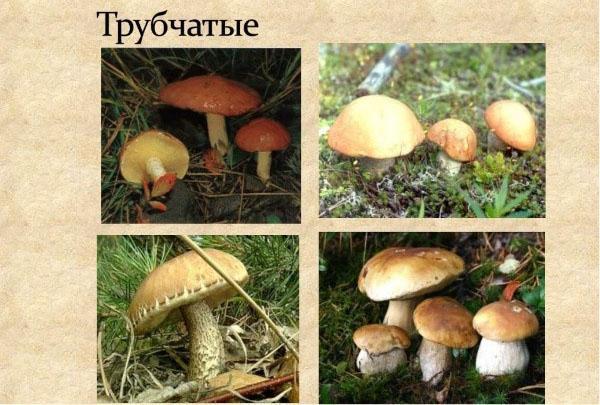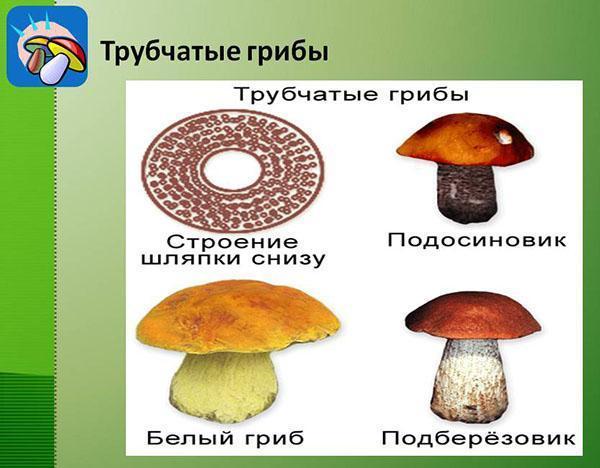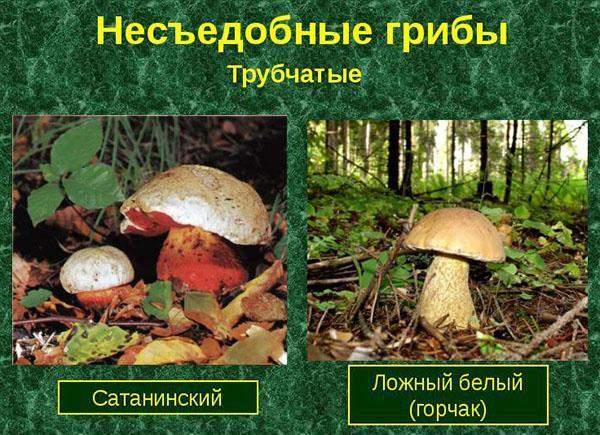How to learn to recognize tubular mushrooms
 White mushroom is considered one of the most valuable and delicious gifts of the forest. Did you know that it belongs to the tubular mushrooms? Their fleshy and dense pulp is perhaps the most delicious among other representatives of the mushroom kingdom, and certainly the most useful and nutritious. The white king of mushrooms is not the only one of this species; in addition, there are inedible tubular specimens, and even poisonous ones. Let's take a closer look at what tubular mushrooms are and what they are.
White mushroom is considered one of the most valuable and delicious gifts of the forest. Did you know that it belongs to the tubular mushrooms? Their fleshy and dense pulp is perhaps the most delicious among other representatives of the mushroom kingdom, and certainly the most useful and nutritious. The white king of mushrooms is not the only one of this species; in addition, there are inedible tubular specimens, and even poisonous ones. Let's take a closer look at what tubular mushrooms are and what they are.
This type of mushroom is characterized by symbiosis with woody species: almost every mushroom grows under its "own" tree.
Characteristics and classification of tubular mushrooms

The peculiar structure of the cap contributes to the fact that it absorbs a lot of moisture, which should be taken into account when cooking.
Among tubular mushrooms, most species are edible, boiled, pickled, and fried. They retain their taste even when dried, but since the color is not always preserved after drying, such delicacies are usually divided into two unequal groups:
- White, in which the flesh remains light even when dried. These include only boletus, they are also porcini mushrooms (for which they got their name).
- Black - all other tubular mushrooms, the dried pulp of which becomes dark in color.
When collecting edible tubular mushrooms, it is better to leave old specimens in the forest: they contain less nutrients, and in the process of heat treatment, the flesh of the cap in most species becomes jelly-like.
At the same time, among the tubular mushrooms there are also frankly tasteless, officially recognized inedible species with bitter pulp. Even a poisonous mushroom has crept in here, but more on that later.
Popular edible tubular
Some of the most popular edible tubular mushrooms with excellent taste characteristics are:
- Boletus (White mushrooms). They grow in small families, mainly under conifers or birches, depending on this, the color of the cap changes from dirty gray to dark brown. The sponge itself under the hat is also different, in some species it is white, in others it has a yellow-green color. The leg is in the form of a barrel, thick, fleshy. The pulp is light and has a characteristic odor.

- Butterlets. Residents of pine forests love to grow in families. The fleshy brown caps are covered with very slimy skin. The leg can be lighter or darker, also dense in structure. The sponge is most often yellow.

- Flywheels. Small mushrooms grow on sandy soils. Hats can be dirty yellow or pale green, yellow flesh turns blue when broken. The leg is thick.

- Boletus boletus. They grow between the roots of birch families. Hemispheric hats are light at first, but then turn brown. The leg is off-white, covered with frequent gray scales. The pulp is light, but darkens after drying.

- Aspen mushrooms. Fleshy mushrooms grow, respectively, under the aspen trees. The convex cap resembles the color of autumn foliage, orange-brown.The leg is high, thickens in the lower part, covered with black scales. The sponge is yellow-gray, the pulp, when broken, becomes first blue, and then almost black.

- Polish mushroom. Grows among fallen pine trees on damp soils. The hat is dark brown, with a white-yellow sponge under the bottom. The leg is rather high, thick, light brown with a barely visible pattern. When cut, the light pulp turns blue, and then becomes brown, which distinguishes the Polish mushroom from the white one.

- Duboviks. They grow in oak and linden forests. Large caps with a diameter of up to 20 cm have different shades of brown, the skin is velvety at first, acquires a glossy shine with age. The spongy layer is yellow in young fungi, orange in adults. The yellowish leg is quite high, up to 12 cm, thick, covered with a reddish mesh. On contact with air, the yellow flesh quickly turns blue.

Some scientists classify oak trees as conditionally edible species, and the use of their raw pulp generally causes symptoms of poisoning. However, properly cooked oak wood is no less tasty than boletus, and very edible.
Attention, danger - poisonous tubular mushroom false boletus
 The only representative of the tubular that can harm a person is the satanic mushroom. It was not by chance that he got into trust in them, because outwardly it has the maximum resemblance to a real boletus, as a result of which mushroom pickers call him so: "false boletus".
The only representative of the tubular that can harm a person is the satanic mushroom. It was not by chance that he got into trust in them, because outwardly it has the maximum resemblance to a real boletus, as a result of which mushroom pickers call him so: "false boletus".
His hat is in the shape of a hemisphere, with a smooth grayish skin, slightly velvety. The dense leg resembles a keg, orange at the top and slightly tapering. The center of the leg of the poisonous tubular mushroom is decorated with a red mesh, which turns into a yellow-brown color near the ground.
You can distinguish the false boletus from the real one by the blue pulp after the cut, which first turns red. In addition, the middle part of the stem has a brightly colored red mesh.
Inedible tubular
There are many among the tubular mushrooms and those that outwardly are the very charm, but are absolutely unsuitable for food because of the bitter pulp. Some of them are easy to recognize by their unpleasant aroma, however, not everyone has it.
The most famous inedible tubular mushrooms include:
- Pepper mushroom (aka pepper oil can or pepper flywheel). Most often it forms mycosis with deciduous species (birches). Outwardly, it looks like a regular oiler, but the spongy layer is painted in brighter colors (reddish). Rusty convex cap, covered with a slightly velvety dry skin. The leg is of the same color, but lighter, yellowish near the ground. The pepper mushroom got its name for the peculiar pungent taste of the pulp. Because of this, it is considered inedible. However, some gourmets manage to use it as a condiment (instead of pepper).

- Gall mushroom (aka bitter mushroom). It has a thick, fleshy cap of a golden-red color with a matte dry skin, a spongy layer is white, in older specimens it acquires a pink tint. The yellow leg is decorated with a brown mesh pattern, and turns pink on the cut, which distinguishes the bitter from the porcini mushroom, to which it looks so much.

- Pseudo-birch porphyry. The thick cap is semicircular at first, then straightens, olive-brown, covered with a velvety skin. The dense leg is painted in the same color, in the central part it is thicker. The sponge in young fungi is light gray, turns brown with age. When broken, the white pulp turns red, tastes bitter and smells bad. However, some mushroom pickers assure that after a long heat treatment, mushrooms can be eaten.

- Trametes Trog. One of the species of tinder fungus, grows on dry deciduous trees in the form of a multi-tiered growth. A spongy thick layer in the form of large pores becomes cork. The edges of the cap are thinner, and the surface is covered with a hard skin in the form of bristles, painted in a gray-yellow color. The pulp is light and very tough, without taste, therefore it is not used for food.

The importance of tubular mushrooms should not be underestimated. Despite some species that do not differ in taste, among the spongy mushrooms with fleshy pulp and thick hats are some of the most delicious and healthy gifts of the forest. Going for delicacies for a festive dinner, look carefully under the trees and be sure to put a couple of boletus or butter mushrooms in your basket.